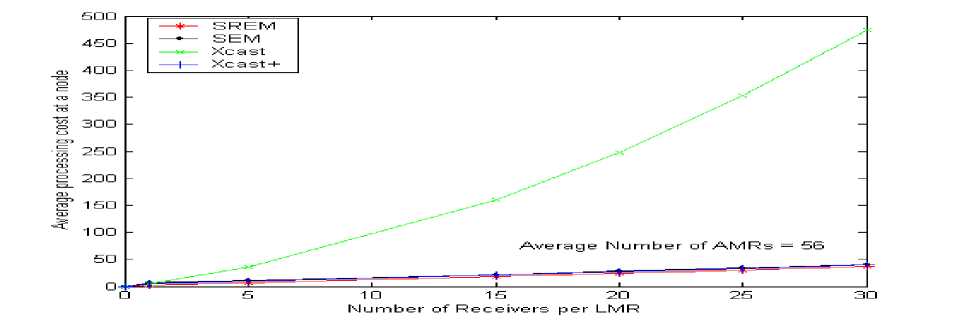the dominant role to the join/leave delay cost; if γ << 1, means that the delivering cost over
links dominate the join/leave delay cost; otherwise, the processing at nodes and delivering
over links contribute to the join/leave delay cost in the same level. Therefore, the average
joins /leave delay cost for all receivers is given by
1 NR
T cos t =----∑ T ( i ), (6)
cos t
NR i=1
Where: N is the number of receivers
R
After discussing the simulation environment and the evaluation metrics, the simulation
results are presented. For each simulation result, the simulation was run 10,000 times for
each protocol, by changing the seed value in the Waxman’s probability model[67] used to
generate the topology to minimize the error rate in the output results and then the results are
shown by average.
Figure 4.20 shows the average processing cost as a function of number of receivers for
SReM, SEM, Xcast and Xcast+, where the number of LMRs is fixed at 20, these LMRs
represents the end routers where the receivers are directly connected to these LMRs. It can be
noticed that processing cost in SReM, SEM and Xcast+ increases approximately linearly, but
increases dramatically in Xcast. This is because Xcast encodes the receivers address in its
packets and these packets will grow exponentially when the number of receivers increases, as
a result the cost will increase. This means that Xcast faces the scalable problem and it is just
a solution for small multicast groups and other three protocols are more scalable than Xcast.

Figure 4.20 Average processing cost as a function of number of receivers per LMR
86
More intriguing information
1. BARRIERS TO EFFICIENCY AND THE PRIVATIZATION OF TOWNSHIP-VILLAGE ENTERPRISES2. Nach der Einführung von Arbeitslosengeld II: deutlich mehr Verlierer als Gewinner unter den Hilfeempfängern
3. Getting the practical teaching element right: A guide for literacy, numeracy and ESOL teacher educators
4. The name is absent
5. The name is absent
6. PROJECTED COSTS FOR SELECTED LOUISIANA VEGETABLE CROPS - 1997 SEASON
7. IMMIGRATION POLICY AND THE AGRICULTURAL LABOR MARKET: THE EFFECT ON JOB DURATION
8. The name is absent
9. Tariff Escalation and Invasive Species Risk
10. ANTI-COMPETITIVE FINANCIAL CONTRACTING: THE DESIGN OF FINANCIAL CLAIMS.